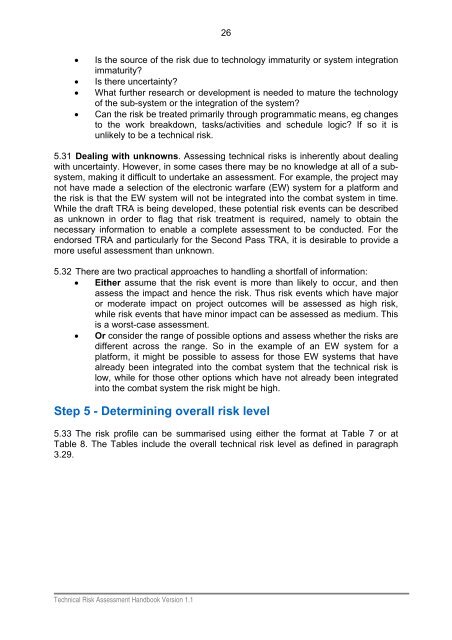Technical Risk Assessment Handbook - Defence Science and ...
Technical Risk Assessment Handbook - Defence Science and ...
Technical Risk Assessment Handbook - Defence Science and ...
You also want an ePaper? Increase the reach of your titles
YUMPU automatically turns print PDFs into web optimized ePapers that Google loves.
26<br />
• Is the source of the risk due to technology immaturity or system integration<br />
immaturity<br />
• Is there uncertainty<br />
• What further research or development is needed to mature the technology<br />
of the sub-system or the integration of the system<br />
• Can the risk be treated primarily through programmatic means, eg changes<br />
to the work breakdown, tasks/activities <strong>and</strong> schedule logic If so it is<br />
unlikely to be a technical risk.<br />
5.31 Dealing with unknowns. Assessing technical risks is inherently about dealing<br />
with uncertainty. However, in some cases there may be no knowledge at all of a subsystem,<br />
making it difficult to undertake an assessment. For example, the project may<br />
not have made a selection of the electronic warfare (EW) system for a platform <strong>and</strong><br />
the risk is that the EW system will not be integrated into the combat system in time.<br />
While the draft TRA is being developed, these potential risk events can be described<br />
as unknown in order to flag that risk treatment is required, namely to obtain the<br />
necessary information to enable a complete assessment to be conducted. For the<br />
endorsed TRA <strong>and</strong> particularly for the Second Pass TRA, it is desirable to provide a<br />
more useful assessment than unknown.<br />
5.32 There are two practical approaches to h<strong>and</strong>ling a shortfall of information:<br />
• Either assume that the risk event is more than likely to occur, <strong>and</strong> then<br />
assess the impact <strong>and</strong> hence the risk. Thus risk events which have major<br />
or moderate impact on project outcomes will be assessed as high risk,<br />
while risk events that have minor impact can be assessed as medium. This<br />
is a worst-case assessment.<br />
• Or consider the range of possible options <strong>and</strong> assess whether the risks are<br />
different across the range. So in the example of an EW system for a<br />
platform, it might be possible to assess for those EW systems that have<br />
already been integrated into the combat system that the technical risk is<br />
low, while for those other options which have not already been integrated<br />
into the combat system the risk might be high.<br />
Step 5 - Determining overall risk level<br />
5.33 The risk profile can be summarised using either the format at Table 7 or at<br />
Table 8. The Tables include the overall technical risk level as defined in paragraph<br />
3.29.<br />
<strong>Technical</strong> <strong>Risk</strong> <strong>Assessment</strong> <strong>H<strong>and</strong>book</strong> Version 1.1

















